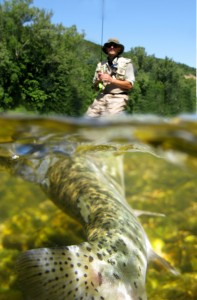Native Trout, Also Known as Brook Trout or Brookies, a North American Treasure
According to the Linnaeus system of naming species, the common brook trout, also known  as native trout, isn’t really a trout at all, but actually a member of the char family. The brook trout is classified as; Family - Salmonidae, Genus - Salvelinus, Species - fontinalis. It doesn’t really matter to most people if this beautiful, wild, and elusive fish is a trout or a char. Many people enjoy catching brook trout and many more enjoy the delicious meat that can range from white to salmon pink.
as native trout, isn’t really a trout at all, but actually a member of the char family. The brook trout is classified as; Family - Salmonidae, Genus - Salvelinus, Species - fontinalis. It doesn’t really matter to most people if this beautiful, wild, and elusive fish is a trout or a char. Many people enjoy catching brook trout and many more enjoy the delicious meat that can range from white to salmon pink.
While some people prefer to catch brook trout using artificial flies, many others use live bait or artificial lures, like spinners or spoon bait. The laws regarding brook trout vary from state to state in the United States. There are restrictions on the use of live bait in some jurisdictions, so it is always a good idea to check local laws and of course, to have a valid fishing license for that state. Some states also require persons who take brook trout to have a special “trout stamp,” that can be purchased at the same time the fishing license is bought.
Although specimens as large as 29 inches long have been reported, brook trout usually do not get very big, a good sized trout in many areas being about twelve inches long, and the average being much less than that. But what “brookies,” as they are often called, lack in size, they make up for in fighting spirit and wariness.
Anyone who fishes for brook trout soon finds out that fishing for brookies is as much hunting and stalking as it is fishing. For instance, in order not to spook the fish, you must approach the bank of the streams slowly and quietly. Casting a shadow into the water will almost always scare the trout and they will scatter, racing upstream or down, and you will not see them or have a chance to catch them again.
Loud noises or splashes will alert them to your presence and make it more difficult to convince them that your bait, whether live or artificial, is a good deal. Even the choice of clothing is important. Wearing dark colors is recommended as bright or light colors stand out more and you may be spotted by your quarry.
Brook trout are found in many streams and brooks, often in such small bodies of water that you would swear no fish of any size could survive there. The most important factors that determine the presence of brookies is the temperature and Ph of the water, as well as the availability of food. If the water is moving and doesn’t get too warm in the summer months, there are probably a few brook trout to be found.
While many people love the tasty flesh of brook trout, because it is a game fish and highly sought after, many people now practice catch and release with brook trout to make sure that there will always be more trout to catch next season.
Just catching a brook trout and holding it in your hands briefly, while you gently remove the barbless hook, is an amazing experience. They are completely wild and beautiful to see with a marbled pattern, called vermiculations, of light shades found on their flanks and backs. They also have bright red spots that often have a halo of blue around them on their sides. Some of the males develop a very red belly when they are spawning the eggs of the females that are laid in the gravel of the streambed.
While other species of fish, including some trout, have been introduced to North America by humans, brook trout have been a native species for thousands of years and truly deserve their name, native trout.
